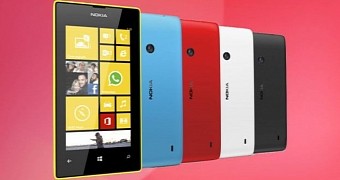It’s true that Windows Phone users seem to be the most loyal, but Microsoft’s operating system has a very low market share worldwide. Even though there are some European countries where Microsoft may compliment itself for having a two-digit market share, overall the situation is not that good at all.
Windows Phone platform is now the third most popular mobile platform after switching places with BlackBerry, which is now fourth. Unfortunately, that doesn’t mean anything considering Microsoft’s operating system has less than 5% market share worldwide.
If Microsoft doesn’t change something in the next couple of months that would make consumers choose Windows Phone, then the platform won’t stand a chance against Android and iOS.
The good news is that there’s hope for Microsoft and Windows Phone, as many handset makers and carriers are determined to support the Redmond-based company in its attempt to make the platform more popular among consumers.
Nokia Lumia 520 is still the best-selling Windows Phone handset
In a recent interview for The Guardian, Alcatel’s VP Dan Dery said that “carriers from across the world have consistently told us that entry-level Windows Phones work, but not at the high end.”
The statement shouldn’t surprise anyone considering the most popular Windows Phone handset is the Nokia Lumia 520, which was launched in April 2013 and still tops the charts in many important markets for Microsoft to this date.
Microsoft is not the only company that launches Windows Phone handsets, but it’s one of the few that releases high-end smartphones.
Huawei, HTC, LG and Samsung launched mid-range and budget-friendly smartphones over the years and had some success, but no device sold better than the Lumia 520.
One of the reasons low-end Windows Phone handsets sell even better than those powered by Android is pretty simple: they are cheaper and offer the same level of functionality and user experience as high-end smartphones.
Obviously, they do not have state-of-the art displays or powerful CPUs and cameras, but Windows Phone offers the same experience on a Lumia 520 like it would on the Lumia 930, for example.
More smartphones from other handset makers could mean more customers
According to Dery, there’s no telling whether customers purchase low-end Windows Phone devices because the operating system is very good for this kind of smartphones, or simply due to the fact that people want Nokia phones at affordable prices.
“We’re not interested in high-end devices – so Windows Phone producing a very, very good consumer experience at the entry level, which is not the case for other software, is a very interesting prospect. It seems a lot more natural for first-time smartphone users – it’s surprising and I don’t know why, but that seems to be the case reported from carriers,” added Dery.
So there’s hope for Windows Phone and Microsoft especially at the low-end tier, but is the Redmond-based company aware of this aspect? We believe it is, hence the fact that Microsoft recently made Windows Phone free for OEMs and inked lots of partnerships with handset makers who agreed on releasing budget-friendly Windows Phone handsets in the coming months.

 14 DAY TRIAL //
14 DAY TRIAL //